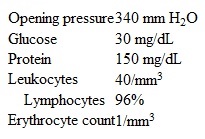A 34-year-old man is brought to the emergency department due to 3 weeks of intermittent fever, headache, malaise, and night sweats. Over the last few days, his headaches have worsened, and he has had blurry and double vision. The patient uses injection drugs and was treated for staphylococcal endocarditis 4 years ago. Temperature is 38.1 C (100.6 F) , blood pressure is 150/100 mm Hg, pulse is 66/min, and respirations are 18/min. BMI is 18.4 kg/m2. The patient is ill in appearance and somnolent but easily arousable and oriented. There are white plaques on the oropharyngeal mucosa and several skin lesions resembling molluscum contagiosum. There is increased resistance to passive neck flexion. Neurologic examination reveals leftward gaze restriction in the left eye but no other focal weakness or sensory loss. Funduscopy reveals bilateral papilledema. A noncontrast CT scan of the head shows no abnormalities. The patient receives a lumbar puncture; results of the spinal fluid analysis are as follows:  Which of the following is the best pharmacotherapy for this patient's current condition?
Which of the following is the best pharmacotherapy for this patient's current condition?
Definitions:
Fetal Monitors
Devices used during pregnancy and childbirth to monitor the heart rate and other vital signs of a fetus.
General Anesthesia
A medical procedure that uses medication to induce a state of unconsciousness and loss of sensation throughout the entire body.
Uterine Contractions
Uterine contractions refer to the tightening and relaxation of the uterine muscles, typically experienced during menstrual cycles and more intensively during labor.
Neonate
A newborn infant, especially one less than four weeks old.
Q60: An 8-year-old girl is brought to the
Q157: A 65-year-old woman comes to the office
Q178: A 16-year-old boy is brought to the
Q363: A 50-year-old woman comes to the office
Q409: A 65-year-old woman comes to the physician
Q436: A newborn girl is evaluated in the
Q642: A 24-year-old man is brought to the
Q694: A study examines the role of different
Q834: A 34-year-old man is brought to the
Q972: A 55-year-old Caucasian male is brought to the